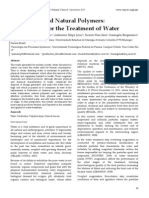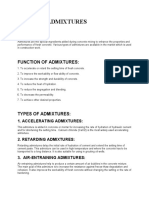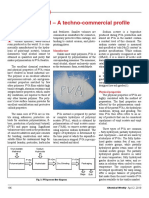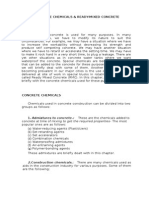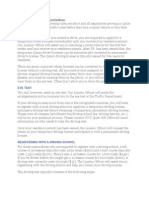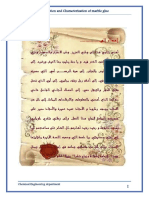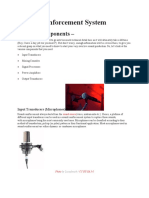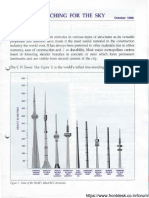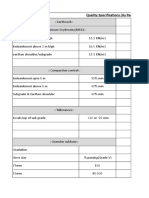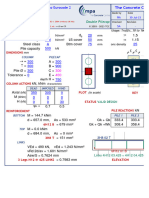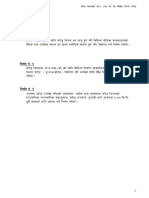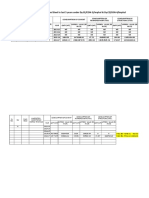Concrete Admixtures - Plasticizers FD PDF
Uploaded by
HARSHITA JAINConcrete Admixtures - Plasticizers FD PDF
Uploaded by
HARSHITA JAINJULY 1998
CONCRETE ADMIXTURES - PLASTICIZERS
1.0 INTRODUCTION :
There are essentially four ingredients in concrete, i.e. the coarse aggregates,
fine aggregates, cement and water. However, in order to improve certain prop-
erties of concrete both in the plastic and hardened state, it is necessary to add
the fifth ingredient in the concrete mix. This fifth ingredient can be a mineral or
3 chemical admixture.
If the concrete mix is properly designed, it does do not need any admixture.
However, there may be a need to produce concrete with a particular result and
using admixture could be the most convenient way. It is very important to note
that any type of admixture should be used only when there is a valid reason for
using it.
There are several types of admixtures available but the most popular and most
often used is the plasticizer. The plasticizer is a chemical admixture and this
publication covers in detail its classification, interaction, useful effects on con-
crete properties and precautions to be exercised in its usage.
Plasticizers have been extensively used in concrete mixes for the past three
decades the world over. However, in India this usage has considerably increased
in the last five years. Plasticizers or other type of admixtures are not a substitute
~or badly designed concrete mixes or bad construction practices. They are
aids to modify good mixes and good construction practices to achieve certain
specific requirements which can be conveniently achieved. There are two types
of plasticizers. The ordinary plasticizer is one type and the other is a superior
plasticizer or superplasticizer.
2.0 CLASSIFICATION :
Plasticizers are also called water reducing admixtures and are classified as
follows:
2.1 Ordinary water reducing plasticizers which enable upto 15 percent of water
reduction.
https://www.frontdesk.co.in/forum/
2.2 High range water reducing superplasticizers which enable upto 30 per-cent
of water reduction.
The water reducing admixtures are further classified as normal, retarding
or accelerating. Some plasticizers also cause air entrainment in concrete.
Superplasticizers are clasified based on their chemical composition:
0 Sulphonated melamine - Formaldehyde condensates
0 Sulphonated napthalene - Formaldehyde condensates
0 Modified lignosulphonates
0 Carboxylated acrylic esters copolymers
0 Others like sulphuric-acid esters, amide polysaccharide mixtures,
carbohydrate esters etc.
The Sulphonated melamine based plasticizers are generally preferable if
ambient temperatures are low, while sulphonated napthalene based
plasticizers are preferable in high ambient temperatures due to their good
workability retention quality. Therefore they are more suitable for Indian
conditions.
Lignosulphonates at times, also give air entrainment and set retardation in
concrete. Polycarboxylate admixtures are high performance plasticizersJ_..,
which also help in slump (workability) retention for a longer period.
For the sake of convenience, the word "Plasticizer" used in this booklet
shall henceforth mean both plasticizer as well as superplasticizer.
3.0 PURPOSE :
Concrete must be placeable and durable. Durability includes considerations
for appropriate strength for local conditions. Initially, concrete should have quali-
ties like cohesiveness and workability so that it can be placed and compacted
with ease. Once concrete hardens, strength and durability considerations are
of prime importance to concrete.
2
https://www.frontdesk.co.in/forum/
While designing a concrete mix all aspects of concrete requirements both in
fresh (plastic) and hardened (set) form should be considered. The purpose for
using plasticizers to improve certain requirements of concrete should be clearly
defined and understood.
Plasticizers are generally used to achieve the following:
3.1 In Fresh Concrete :
0 Increase workability and /or pumpability without increasing the water/
cement ratio (See Figure No. 1).
0 Improve cohesiveness and thereby reducing segregation or bleeding.
0 Improve to some extent set retardation. (See Figure No.2)
3.2 In Hardened Concrete:
0 Increase Strength by reducing the water/cement ratio, maintaining the
same workability.
Figure 1 : Plasticized concrete being pumped into a Figure 2 : A Retarder cum plasticizer admixture was
raft foundation at a Hotel Project In Tashkent. used to produce pumpable concrete for a massive pour
of a Turbo Generator Deck, 500 MW Unit 6, Trombay.
3
https://www.frontdesk.co.in/forum/
0 Reduce permeability and improve durability by reducing the water/
cement ratio.
0 Reduce heat of hydration and drying shrinkage by reducing the cement
content.
4.0 INTERACTION:
Plasticizers interact both physically and chemically with cement particles.
4.1 Physical Interaction :
Plasticizers are principally surface active (surfactants). They induce al
negative charge on the individual cement particles such that the fine cement
particles are dispersed due to inter particle repulsion.
Fine cement particles being very small, clump together and flocculate when
water is added to concrete. This ionic attraction between the particles trap
a considerable volume of water and hence water required for the workability
of the concrete mix is not fully utilised. Negative charges are induced on
the fine cement particles causing floes to disperse and release the
en~trapped water. Water reducing admixtures or plasticizers therefore help
to increase the flow of the concrete mix considerably. FIGURE No.3
illustrates this disperse mechanism due to ionic repulsion.
FREE WATER
FREE WATER
Before After
Cement Particles
~ Entrapped water
Figure 3 : Disperse mechanism of cement particles in concrete b efore and after the addition of a plasticizer.
4 https://www.frontdesk.co.in/forum/
4.2 Chemical Interaction :
Essentially water reducing admixtures perform to plasticize concrete more
by physical interaction than by chemical interaction. The chemical
inter-action is generally responsible for slump retention or retardation of
concrete.
When admixtures are dosed, the initial hydration of aluminate and silicates
is delayed since some chemicals strongly affect the formation and growth
of cystals of the hydrated phases. The chemical admixture first gets
absorbed on the hydrated phases containing alumina and depending on
the quality of the admixture and CsA content of cement, it is further absorbed
on other hydrated phases of silicates. This inhibition ofthe surface hydration
reaction of the cement particles leaves more water to fluidise the mix and
thereby increase the workability of concrete and also retain the workability
for a longer period.
Numerous organic compounds such as lignosulphonates, hydroxy
carboxylic and Carboxylic acids and their salts etc. cause retardation.
4.3 SUMMARY :
Concrete gets fluidised or attains high workability when plasticizers or
superplasticizers are used.
To achieve a homogeneous distribution of water and optimal utilisation of
the cement particles, water get dispersed and flocculation is prevented
due to the following effects :
0 Reduction of surface tension of water and lubrication of the film between
• the cement particles.
l 0 The induced electrostatic repulsion due to absorption of charged
polymer on the cement particles causes dispersion of cement grains
and releases the trapped water from the cement floes (See Figure 3).
0 Steric hindrance prevents particle-to-particle contact.
0 Change in morphology of hydration product.
0 Retardation due to the inhibition of the hydration reaction of cement
particles leavs more water to plasticize the mix.
5
https://www.frontdesk.co.in/forum/
5.0 FACTORS AFFECTING ADMIXTURE REACTION :
The following factors influence the plasticizing effect of water reducing chemicals :
5.1 Types of Superplasticizers :
It is difficult to compare the efficiency of one plasticizer from another. There
are many inherent properties of an admixture which influences its efficiency.
The prime factor which increases the efficiency is molecular weight. Higher
the molecular weight, higher is the efficiency of the plasticizer in concrete.
However, beyond optimum value of molecular weight the efficiency is
expected to decrease. \....
5.2 Dosage:
The optimal dosage of a superplasticizer is important. Dosage beyond the
optimal dosage may be detrimental and can cause segregation or
excessive retardation which can be harmful to concrete. The dosage
optimisation can be done by using the Marsh Cone apparatus or by using
the minislump test or by the flow table methods described in ASTM C 109.
The Marsh Cone test gives the measure of the flow time which is directly
related to the viscosity of the grout. In this test; water, cement and
superplasticizer are thoroughly blended and a measured quantity of this
grout is poured into a conical vessel with a standard opening at the bottom.
The time taken for a given volume of the grout to pass through the standard
opening is measured.
It is generally observed that viscosity decreases as the superplasticizer
dosage increases until a certain optimal superplasticizer dosage is reached.
Beyond this dosage, any further addition of superplasticizer does not
significantly reduce viscosity. This limiting dosage is called a saturation
point beyond which higher dosages are not added or recommended.
5.3 Compatibility with cement :
All plasticizers/superplasticizers do not produce the same extent of concrete
mix improvement with all types /brands/grades of cement. It is there-fore
essential to ensure that cement and admixtures are compatible with each
other.
6 https://www.frontdesk.co.in/forum/
The chemical and physical interaction can depend on their individual
chemical and physical properties. Fineness, chemical composition, C~
content, S03 (gypsum) content of cement and the chemical composition
and molecular weight of the plasticizer are mainly responsible for their
interaction with each other. It is therefore preferable to study different
combinations before finalising an optimum combination.
5.4 Concrete Mix Design and Mix Composition :
Every ingredient in the concrete mix is responsible for the performance of
the plasticizer. The properties which influence the performance or efficiency
of the plasticizer are :
Water The Wetter the mix, the better is the physical
interaction of the plasticizer and hence, better
is the dispersion in the mix.
Coarse Aggregate Porosity, proportion and grading
influences the performance of the palsticizer.
Fine Aggregates Porosity, proportion, grading and the silt content
influences the performance of the plasticizer.
Cement Fineness, gypsum content and C3A content.
Out of the above three properties, the C 3 A
content plays a major role on the efficiency of
the plasticizer. A higher C3 A content can reduce
the efficiency of the plasticizer.
Other Admixtures The efficiency of the plasticizer may also get
influenced if other chemical or mineral
admixtures like air-entraining agent, flyash, slag
or silica fume are used.
It can therefore be concluded that proper trials are necessary before a
particular dosage of plasticizer is fixed to achieve the desired efficiency of
dispersion and workability.
5.5 Other Factors :
There are various other factors which can influence the performance of
the admixture and thereby influence the dosage of the admixture or its
performance.
7
https://www.frontdesk.co.in/forum/
5.5.1 High Ambient Temperature and Low Relative Humidity :
Loss of water from the mix due to the above factors will also cause
reduction in the workability and thereby loss of wetness of the mix. This
ultimately results in lowering the efficiency of the plasticizer.
5.5.2 Batching of Plasticizer :
Accuracy of dosage of the
plasticizer for every batch of
concrete produced has to be
done with care and accuracy.
Manual batching, if done, has to
be carefully monitored. Batching
mixing plants having admixture
dispensing arrangements (See
Figure No.4) are most suitable for
accurate batching.
While underdosing of the
plasticizer will cause lower
workability, over dosage of
plasticizer will also be harmful.
Overdosage can cause severe
concrete segregation as well as
excessive retardation especially if
the admixture is lignosulphonate
based and if undesirable
COmponents in the COmmercial Figure 4 : Admixture dispensing arrangement a! a
lignosulphonate are not removed. earching·Mixing plant
5.5.3 Mixing of Concrete Materials :
It is very important that the plasticizer is thoroughly mixed with various
concrete ingredients. The mixing sequence and method, both play an
important role and if done correctly can enhance the performance of
the plasticizer in concrete.
In conventional concrete, produced by tilting or reversible drum mixers,
the plasticizer is likely to give poor performance as these mixers are not
8
https://www.frontdesk.co.in/forum/
very efficient mixing devices. In any case, manual or hand mixing of
concrete materials when an admixture is used, is ruled out. Efficient
mixing devices such as pan mixers (See Figure No.5) and compulsive
or shaft mixers or other specialised types of mixers will enhance the
performance of the plasticizer as it will be very uniformly and properly
mixed with the other ingredients.
Figure 5 : Plasticized concrete being mixed in a pan mixer.
The most recommended method of dosing the admixture in conventional
concrete mixers is as follows:
0 Add all concrete materials, except the admixture and the last two
litres of water, into the mixer.
0 Mix the materials completely (2 to 3 minutes)
0 Add the required dosage of the plasticizer in a container which has
two litres of water which is yet to be added to the mixed materials.
0 Thoroughly mix the plasticizer in this water.
9
https://www.frontdesk.co.in/forum/
0 Add this plasticizer and water solution into the mixer.
0 Continue the mixing operation for one more minute.
It must be noted that the performance of the plasticizer is generally
dependent on the workability of the concrete.
It must also be noted that if a plasticizer is to be used along with mineral
admixtures like micro silica, flyash or slag then conventional mixers
cannot be used. It will be necessary to use efficient mixing devices like
the ones available on imported batching and mixing plants. In such
cases it will be necessary to also increase the mixing time considerably.._
till the desired dispersion of the plasticizer takes place. The plasticizer
must also be a powerful dispersing agent when used with ultra fine and
very fine materials like micro silica, flyash, slag etc.
6.0. LOSS IN WORKABILITY (SLUMP) :
Concrete, with or without a plasticizer can lose workability due to several fac-
tors. This drop in workability generally takes place from the time the concrete
materials are mixed, to the time the plastic concrete is placed and compacted
at the desired location.
The drop in workability is attributable to the following factors:
0 High Ambient Temperature, low humidity and high wind velocity causes
the water to evaporate from the concrete mix thereby reducing its
workability. ""'
0 Water absorption by aggregates due to their porosity or dryness causes
reduction of water available for the workability purpose and hence there is
a reduction in workability.
0 If the temperatures of the ingredients used in the concrete are high, then the
evaporation of water will be faster, and hence workability will also be lost faster.
0 Due to high ambient temperatures and/or high temperature of cement and
the other materials, the hydration of cement with water will be faster and
10
https://www.frontdesk.co.in/forum/
therefore water will be lost to the hydration process, resulting in the reduction
of water required for workability.
0 High cement fineness and C~ content also accelerates the hydration pro-
cess of cement with water. This in turn causes a drop in workability due to
the loss of water in the cement hydration process.
In a plasticized concrete, the above factors can cause a more rapid drop of
workability as there is less quantity of water in the concrete mix containing the
plasticizer. The low quantity of water available for workability due to the use of
the plasticizer may further reduce on account of the above factors. The follow-
'· ing methods could therefore be adopted :
0 Add the plasticizer a few minutes before placing the concrete in position.
This can be done if equipment like the transit mixers are used.
0 Add the plasticizer using smaller successive dosages at certain time
intervals so that at the time of placing, a required workability is obtained.
This also is possible if equipment like transit mixers are used.
0 Put an over dose of plasticizer, so that the initial workability is high and
therefore it will take longer for the concrete to lose workability.
0 Add an additional dosage of the plasticizer just before placing if workability
observed is not adequate.
However, in warm or hot ambient weather conditions the best option would be to
1\use a retarder cum plasticizer or use a plasticizer with a retarder. Usually single
_yadmixtures are available which can serve both as plasticizers as well as workability
retention or retarding admixtures. This is probably the easiest solu-tion. However,
one must be careful in the selection of such ready made retarding plasticizers as
due to the heterogeneous nature and different molecular weights of the retarder
and plasticizer, they tend to separate out. Therefore such retarding plasticizers
should be vigorously shaken up or thoroughly stirred before use.
7.0 EFFECTS ON PROPERTIES OF FRESH CONCRETE :
7.1 Workability :
The main reason why plasticizers are used in concrete is to improve the
11
https://www.frontdesk.co.in/forum/
workability of concrete. Improved workability helps in the compaction of
concrete and thereby removal of entrapped airfrom within the concrete mass.
Entrapped air within the concrete causes loss of strength and durability
The slump of the concrete mix can be greatly increased if a plasticizer is used.
Table No. 1 below shows the increase of workability of the concrete mix from
25 mm to 100 mm using an admixture dosage of 0.4 % by weight of cement.
Table No.1 :
Concrete Mix Cement W/C Slump Strength (Kg/Cm 2) at
Content (mm)
(Kg/M3 ) 7days 28 days
Reference mix 440 0.37 25 390 540
without Plasticizer
Mix with 440 0.37 100 411 541
Plasticizer
It is clear from the above table that even though workability increased from
25 mm to 100 mm slump, the strength of the concrete mix remained almost the
same as there was no change in the water to cement ratio 0/V/C).
7.2 Cohesiveness :
It is essential to
design a concrete mix
which has proper
cohesiveness (See
Figure No .6).
Cohesive (sticky)
mixes keep the
coarse aggregate and
fine materials in the
concrete mix together.
This helps in reducing
the chances of
segregation and
thereby reduces the Figure 6 : Cohesive and workable plasticized concrete being fed to a
chances of large concrete pump.
12
https://www.frontdesk.co.in/forum/
porosity in the concrete. Cohesive concrete mixes can also reduce bleeding
of concrete and this in turn helps in reduction of plastic shrinkage cracks
and improvement in the strength and durability of the concrete top surface.
7.3 Retardation I Retention of Slump:
Retardation is generally measured by the time taken for concrete to reach
. a particular value of penetration resistance. If an admixture is used to
I achieve retardation then the improvement in retardation is measured as a
difference between the stiffening rate of a reference (without admixture)
mix and the mix containing the admixture.
Retardation of concrete mix using a suitable admixture could be very useful
when large concrete pours are carried out in high ambient temperatures.
High temperatures hasten the setting time of concrete resulting in difficulty
in compaction thereby causing cold joints between the subsequent layers
of concrete. It can result in porosity and problems related to loss of strength
and durability.
Retardation of concrete mix using an admixture prevents formation of cold
joints as the lower layer of the concrete will not stiffen till such time as the
subsequent layer is placed and compacted over it. Plasticizers having
retardation characteristics, if used in a concrete mix, can help in extension
of the setting time of concrete and thereby help in placing and compacting
concrete in a massive pour in warm/hot weather conditions.
Loss of workability of concrete takes place due to several reasons listed in
point 6 of this booklet. This drop in workability takes place from the time
the concrete from the mixer is unloaded to the time it is transported, placed
and compacted in the formwork. A drop in the workability beyond a certain
point will create difficulties in placing and compacting concrete. This in
turn can be harmful to the strength and durability of the concrete. It should
be clearly understood that retardation of the concrete's setting time and
retention of concrete's workability are two separate aspects.
Workability retention, unlike retardation, is not easily defined. Retardation
slows down cement hydration which in one way also helps in retention of
workability as less water is consumed due to cement hydration during the
initial stages and therefore more water is available for workability.
13
https://www.frontdesk.co.in/forum/
However, retardation has little effect on the workability loss. Workability of
concrete with retarding admixture will drop at the same rate as reference
or control mix until a slump of 50 to 75mm is reached. It is only round this
level and below that retardation affects workability loss.
The best way to obtain the required workability at the time of placing and
compacting is by starting at a higher workability. In order to achieve this
there are several ways. Additional water if added will improve the work-ability
but the strength and durability of the mix will be seriously affected. It is
therefore very important that workability improvement should not be done
at the sacrifice of the strength and durability requirements of concrete.
This can be achieved by using a plasticizer which improves the workability
significantly without a change in the water cement ratio or cement content.
If the concrete mix is designed for a higher workability it will take a long
time before the workability falls below the required target value for placing
and compacting the concrete.
Specially formulated retarder cum plasticizers are available with an optimal
combination of both requirements of workability retention as well as retardation.
8.0 EFFECTS ON PROPERTIES OF HARDENED CONCRETE:
In case a higher strength is desired, the plasticizer can be added to a concrete
mix reducing its water requirement and at the same time keeping the workabil-
ity unchanged. Table No. 2 below shows the increase in strength without re-
duction in workability of concrete due to a plasticizer dosage of 0.4% by weight
of cement in the reference mix.
Table No.2:
Concrete Mix Cement W/C Slump Strength (Kg/Cm 2) at
Content (mm)
(Kg/M3 ) ?days 28 days
Reference mix 315 0.60 95 218 291
without Plasticizer
Mix with 315 0.53 90 285 375
Plasticizer
14
https://www.frontdesk.co.in/forum/
https://www.frontdesk.co.in/forum/
Table No.3
Concrete Mix Cement W/C Slump Strength (Kg/Cm 2) at
Content (mm)
(Kg/M 3) 7days 28 days
Reference mix · 460 0.43 100 320 420
without Plasticizer
Mix with 395 0.43 100 336 435
Plasticizer
8.3 Shrinkage and Creep :
Drying shrinkage cracks are generally caused due to loss of water from
the capillary pores smaller than 0.5 micron, loss of absorbed water from
close to solid surface and/or loss of water present between the layers of
calcium-silicate hydrated structure. Details of these aspects have been
covered in our booklet on Drying Shrinkage (Sr.No.28) .
The loss of water as stated above causes strain and the resultant stress
due to volume reduction. If this stress is greater than the concrete strength,
then drying shrinkage cracks are caused.
Higher cement and water content in a concrete mix can cause more drying
shrinkage cracks. Concrete capillary pore refinement due to the use of
mineral or chemical admixtures can also cause more drying shrinkage
cracking problems.
In general these properties of plasticized concrete are not significantly
influenced as compared to identical concrete made without their use. To a
certain extent plasticizers help in reduction of cement or water and therefore
reduction of hydrated paste and hence reduction of problems related to
shrinkage and creep. This advantage is, to a certain extent, countered by
the above fact that plasticizers also help in refinement of the pore structure
of the hydrated cement paste.
16
https://www.frontdesk.co.in/forum/
However, there have been no studies to establish any serious adverse
effects on concrete shrinkage and creep if the dosage of the plasticizer
used is within its allowable limits.
9.0 PRECAUTIONS :
There are some precautions necessary and required to be taken when using
plasticizers in concrete.
0 All plasticizers should be tested adequately for their desired performance
in full scale before being used in any large construction work.
0 It is important to do trial mixes using the plasticizer with same concrete
materials as proposed to be used at the site. This is necessary to judge
the performance and to achieve the desired results. Trials should be taken
with the same brand, grade and type of cement which is proposed to be
used in there actual production at site.
0 Make sure that the right admixture is used. Never use a plasticizer from an
unmarked con~ainer. All admixtures should be properly stored and labelled.
Containers must be kept closed to prevent accidental contamination.
0 Make sure that the plasticizer is added to the concrete mix in a correctly
measured proportion. Adding more or less could be harmful to the concrete
mix. It is recommended to use dispensers for dosing liquid plasticizers.
They help in accurate measure of dosage. Calibration of the dispenser is
important before use. It is also essential to wash the dispenser after use.
0 Ensure that the admixture is uniformly dispersed on the concrete materials
and therefore it is essential to mix the admixture with water before dosing
into the concrete mix. More details are covered in point 5.5.3 above.
0 Plasticizers should be free from chlorides and sulphates.
0 If plasticizers are used after a lapse of time, it is essential to stir the contents
in the container before using it. The shelf life of the plasticizers can be
around one year but these should be stored in the original container and
protected from sunlight and frost.
17
https://www.frontdesk.co.in/forum/
0 If aggregates have excessive moisture (say containing about 15% of
required water) they can be mixed with cement for 30 seconds to 1 minute
before the mixing water with the plasticizer is added. If partial hydration of
cement particles is allowed before the plasticizer comes in contact with
the cement it is beneficial to d ispensive action and slump retention.
0 It is most important to remember that plasticizers are not substitutes for
good concrete practices.
10.0 CODES OF PRACTICE :
Table No.4 below gives the requirements of various standards for plasticizers
or normal water reduction admixtures.
Table No.4:
Plasticizer (Water Reducing Admixture) Summary
British (BS 5075), American (ASTM C 494),
Australian (AS 1478 and 9) and Indian (BIS 9103)
Property Requirement
Water Content
BS - reduction Atteast 5%
ASTM - maximum 95% of control
AS- maximum 95% of control
BIS - maximum 95% of control ~
Stiffening Time- BS
0.5 N/mm2 Within+ 1 h of control
3.5 N/mm 2 Within + 1 h of control
Setting Time - ASTM
Initial 3.5 N/mm2
Not more than 1 h earlier nor 11/2 h later
Final 27.6 N/mm2
Not more than 1 h earlier nor 11/2 h later
18 https://www.frontdesk.co.in/forum/
Property Requirement
Setting Time - AS
Deviation from Control:
Initial 3.5 N/mm 2 Maximum ± 1 hour
Final 27.6 N/mm 2 Maximum ± 1 hour
l
Setting Time • BIS
j Allowable deviation
from control sample
"' Initial maximum
Final maximum
± 1 hour
± 1 hour
Compressive Strength
% of control minimum
Age
3 days- ASTM 110
AS 110
BIS 110
7 days- BS 110
ASTM 110
AS 110
BIS 110
\J
28 days- BS 110
ASTM 110
AS 110
BIS 110
11.0 CONCLUSIONS :
Unfortunately very little thought is given to the durability requirements of con-
crete structures in our country. Durability requirements should be incorporated
while designing concrete mixes so that concrete can withstand the environ-
mental pollutants in a superior manner. Developed countries have come to a
19
https://www.frontdesk.co.in/forum/
definite conclusion that to improve the durability of reinforced concrete struc-
tures it is essential to go for high strength, most often above 40 N/mm 2 con-
crete. This is due to the fact that all high strength concrete has to be produced
with a very low water to cement ratio and a low water to cement ratio makes
concrete less permeable, than concrete made from a higher water to cement
ratio. If concrete is impermeable it prevents ingress of aggressive chemicals
which attack mainly the steel reinforcement in concrete or at times the concrete
itself.
Plasticizers help in achieving a higher strength and lowering the water to ce-
ment ratio. This gives concrete high strength and durability without reduction
in the workability requirements of concrete.
Mineral admixtures such as micro silica, tlyash and slag are also used in prepara-
tion of high performance concrete to improve the impermeability of concrete in
a very aggressive environment. Since these materials are ultra or very fine ma-
terials, the surface area of the concrete materials significantly increases. This in
turn increases the water demand. It also results in the formation of floes and
water entrapment due to which workability drops considerably if the water to
cement ratio is controlled. It is inevitable to use plasticizers due to their dispers-
ing and water reducing action whenever mineral admixtures are used for high
performance concrete.
Once the conventional concrete mixes in form of 1:2:4 or 1:1 % : 3 are aban-
doned in favour of correctly designed concrete mixes, more extensive use of
plasticizers will come into existence .
• · .. '' • 1 \ -';'
,.: . . .. .'
• \ ; .•..• ( . i ...
20
https://www.frontdesk.co.in/forum/
You might also like
- Admixtures Types of Admixtures: Engineering MaterialsNo ratings yetAdmixtures Types of Admixtures: Engineering Materials11 pages
- Project Report Physico-Chemical Analysis and GisNo ratings yetProject Report Physico-Chemical Analysis and Gis71 pages
- Manufacturing Bioplastics From Organic Waste:: Opportunities and Challenges in Biofuel Waste ApplicationsNo ratings yetManufacturing Bioplastics From Organic Waste:: Opportunities and Challenges in Biofuel Waste Applications31 pages
- Polycarboxylate Based Superplasticiser For Applications in Self Compacting High Performance ConcreteNo ratings yetPolycarboxylate Based Superplasticiser For Applications in Self Compacting High Performance Concrete12 pages
- Lab Report For Epoxy Resin Polymer Concrete by GroupbbbbbbbNo ratings yetLab Report For Epoxy Resin Polymer Concrete by Groupbbbbbbb23 pages
- Immediate download Drinking Water Treatment 5 Calco carbonic Equilibrium and Disinfection 5th Edition Kader Gaid ebooks 2024100% (10)Immediate download Drinking Water Treatment 5 Calco carbonic Equilibrium and Disinfection 5th Edition Kader Gaid ebooks 202481 pages
- Additional Reading Fillers For Papermaking 1998No ratings yetAdditional Reading Fillers For Papermaking 199810 pages
- Coagulants and Natural Polymers: Perspectives For The Treatment of WaterNo ratings yetCoagulants and Natural Polymers: Perspectives For The Treatment of Water8 pages
- Effect of CaCO3 Size On The Mechanical PropertiesNo ratings yetEffect of CaCO3 Size On The Mechanical Properties7 pages
- Hydration of Cement: Debasish Das 118AR0002100% (1)Hydration of Cement: Debasish Das 118AR00028 pages
- Project Report On Nav Bharath Ventures LTDNo ratings yetProject Report On Nav Bharath Ventures LTD51 pages
- Admixtures: Presented by Engr. Malik Hammad NaseerNo ratings yetAdmixtures: Presented by Engr. Malik Hammad Naseer32 pages
- Types of Admixtures Available in Pakistan and Their67% (3)Types of Admixtures Available in Pakistan and Their10 pages
- Replacement of Cement by Metakaolin and Flyash100% (4)Replacement of Cement by Metakaolin and Flyash66 pages
- 2 Additives, Nanocomposites, and Barrier CoatingsNo ratings yet2 Additives, Nanocomposites, and Barrier Coatings39 pages
- Concrete Chemicals & Ready-Mixed Concrete: 2.construction Chemicals.: There Are Many Chemicals Used AsNo ratings yetConcrete Chemicals & Ready-Mixed Concrete: 2.construction Chemicals.: There Are Many Chemicals Used As8 pages
- Calcium Carbonate For Adhesives & SealantsNo ratings yetCalcium Carbonate For Adhesives & Sealants4 pages
- Laboratory 07: Gravimetric Analysis: Calcium Carbonate in Texas LimestoneNo ratings yetLaboratory 07: Gravimetric Analysis: Calcium Carbonate in Texas Limestone11 pages
- Astman NPG Glycol: Powder Coating Resin PC-17-4N Based OnNo ratings yetAstman NPG Glycol: Powder Coating Resin PC-17-4N Based On4 pages
- JNTU Kakinada - M.Tech - THEORY OF ELASTICITY FRNo ratings yetJNTU Kakinada - M.Tech - THEORY OF ELASTICITY FR1 page
- INFLUENCE of Microsilica and Nano Silica in Concrete Mixtures100% (1)INFLUENCE of Microsilica and Nano Silica in Concrete Mixtures27 pages
- Starting Formulation For Road Marking PaintNo ratings yetStarting Formulation For Road Marking Paint1 page
- Chemical Admixtures For Concrete: K.Prashanth KumarNo ratings yetChemical Admixtures For Concrete: K.Prashanth Kumar21 pages
- Teaching Schedule-Building Science - II (Acoustics & Illumination) Sem. VII Sec.DNo ratings yetTeaching Schedule-Building Science - II (Acoustics & Illumination) Sem. VII Sec.D1 page
- City Audit Assessment Study - Understanding Varanasi City From The Lens of Disability Inclusion PDFNo ratings yetCity Audit Assessment Study - Understanding Varanasi City From The Lens of Disability Inclusion PDF141 pages
- Quality Specifications (As Per Morth 5th Revision)No ratings yetQuality Specifications (As Per Morth 5th Revision)16 pages
- Replacement of Coconut Shell and ResultsNo ratings yetReplacement of Coconut Shell and Results69 pages
- Autoclaved Aerated Concrete (Aac) SlabsNo ratings yetAutoclaved Aerated Concrete (Aac) Slabs14 pages
- DISCIPLINESPECS - 20011105 - Standard Specifications For Concrete Work - PDF - DOC634344No ratings yetDISCIPLINESPECS - 20011105 - Standard Specifications For Concrete Work - PDF - DOC63434425 pages
- Most Asked Civil Engineering Interview Questions (2023) - javatpointNo ratings yetMost Asked Civil Engineering Interview Questions (2023) - javatpoint25 pages
- District Rate - Morang 075 76 Final PDFNo ratings yetDistrict Rate - Morang 075 76 Final PDF78 pages
- Pile Cap SPC 42, SPC 39, SPC 35 & MPC 3 - Oct 06,23No ratings yetPile Cap SPC 42, SPC 39, SPC 35 & MPC 3 - Oct 06,232 pages
- Proposed Evaluation and Repair Procedures For Precast, Prestressed Concrete Girders With End-Zone CrackingNo ratings yetProposed Evaluation and Repair Procedures For Precast, Prestressed Concrete Girders With End-Zone Cracking26 pages
- An Experimental Study On Mechanical Properties of Concrete Paver Block With Partial Replacement of Cement With Metakaolin and Fine Aggregate With Red SoilNo ratings yetAn Experimental Study On Mechanical Properties of Concrete Paver Block With Partial Replacement of Cement With Metakaolin and Fine Aggregate With Red Soil11 pages
- CIV209 Tutorial 2 Assignment - Mix Design - W2024No ratings yetCIV209 Tutorial 2 Assignment - Mix Design - W20244 pages
- Investigation On Strength Criteria and Cost Analysis of Self Compacting Concrete Using Ggbs Giriprasadgoud, Ashwin Kumar, Archanaa DongreNo ratings yetInvestigation On Strength Criteria and Cost Analysis of Self Compacting Concrete Using Ggbs Giriprasadgoud, Ashwin Kumar, Archanaa Dongre12 pages



























